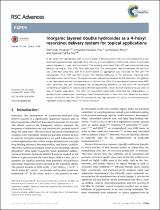 ResearchSpace
ResearchSpace
Inorganic layered double hydroxides as a 4-hexyl resorcinol delivery system for topical applications
JavaScript is disabled for your browser. Some features of this site may not work without it.
- ResearchSpace
- →
- Research Publications/Outputs
- →
- Journal Articles
- →
- View Item
| dc.contributor.author |
Mosangi, Damodar

|
|
| dc.contributor.author |
Kesavan Pillai, Sreejarani

|
|
| dc.contributor.author |
Moyo, Lumbidzani

|
|
| dc.contributor.author |
Ray, Suprakas S

|
|
| dc.date.accessioned | 2017-05-16T10:27:37Z | |
| dc.date.available | 2017-05-16T10:27:37Z | |
| dc.date.issued | 2016-08 | |
| dc.identifier.citation | Mosangi, D., Kesavan Pillai, S., Moyo, L. et al. 2016. Inorganic layered double hydroxides as a 4-hexyl resorcinol delivery system for topical applications. RSC Advances, vol. 6: 77709-77716. | en_US |
| dc.identifier.issn | 2046-2069 | |
| dc.identifier.uri | 10.1039/C6RA19195A | |
| dc.identifier.uri | http://pubs.rsc.org/en/content/articlelanding/2016/ra/c6ra19195a#!divAbstract | |
| dc.identifier.uri | http://hdl.handle.net/10204/9045 | |
| dc.description | © The Royal Society of Chemistry 2016 | en_US |
| dc.description.abstract | In this study, the hydrophobic even skin tone active, 4-hexylresorcinol (HR), was intercalated into a zinc aluminium layered double hydroxide (ZnAl-LDH) by a co-precipitation method and used as a controlled release ingredient in skin care formulation. The resulting nanohybrid (LDH–HR) was characterized using different techniques: XRD, FTIR, TEM, SEM, and TGA. The intercalation reaction between HR and LDH was confirmed using XRD, and FTIR. Some extent of aggregation was observed for the LDH–HR nanoparticles from TEM and SEM results. The thermal behaviour of HR drastically improved after intercalation into the LDH host. Strong electrostatic interactions between the HR and ZnAl-LDH galleries in the nanohybrid and the sustained release of HR from the LDH–HR in phosphate buffered saline (PBS) were observed. We also investigated the de-pigmenting efficiency of the LDH–HR nanohybrid containing formulations in randomized controlled experiments, which showed impressive results after 14 days of topical applications. The LDH–HR nanohybrid significantly minimized the melanogenesis in primary human melanocytes, resulting in overall improvements in even skin tone. Based on the above results, we believe that the LDH–HR nanohybrid has high potential for use as an alternative active ingredient in topical applications for uneven skin tone. | en_US |
| dc.language.iso | en | en_US |
| dc.publisher | Royal Society of Chemistry | en_US |
| dc.rights | CC0 1.0 Universal | * |
| dc.rights.uri | http://creativecommons.org/publicdomain/zero/1.0/ | * |
| dc.subject | Nanocarrier-mediated drug delivery systems | en_US |
| dc.subject | Pharmaceuticals | en_US |
| dc.subject | Uneven skin tone | en_US |
| dc.subject | Topical applications | en_US |
| dc.title | Inorganic layered double hydroxides as a 4-hexyl resorcinol delivery system for topical applications | en_US |
| dc.type | Article | en_US |
| dc.identifier.apacitation | Mosangi, D., Kesavan Pillai, S., Moyo, L., & Ray, S. S. (2016). Inorganic layered double hydroxides as a 4-hexyl resorcinol delivery system for topical applications. http://hdl.handle.net/10204/9045 | en_ZA |
| dc.identifier.chicagocitation | Mosangi, Damodar, Sreejarani Kesavan Pillai, Lumbidzani Moyo, and Suprakas S Ray "Inorganic layered double hydroxides as a 4-hexyl resorcinol delivery system for topical applications." (2016) http://hdl.handle.net/10204/9045 | en_ZA |
| dc.identifier.vancouvercitation | Mosangi D, Kesavan Pillai S, Moyo L, Ray SS. Inorganic layered double hydroxides as a 4-hexyl resorcinol delivery system for topical applications. 2016; http://hdl.handle.net/10204/9045. | en_ZA |
| dc.identifier.ris | TY - Article AU - Mosangi, Damodar AU - Kesavan Pillai, Sreejarani AU - Moyo, Lumbidzani AU - Ray, Suprakas S AB - In this study, the hydrophobic even skin tone active, 4-hexylresorcinol (HR), was intercalated into a zinc aluminium layered double hydroxide (ZnAl-LDH) by a co-precipitation method and used as a controlled release ingredient in skin care formulation. The resulting nanohybrid (LDH–HR) was characterized using different techniques: XRD, FTIR, TEM, SEM, and TGA. The intercalation reaction between HR and LDH was confirmed using XRD, and FTIR. Some extent of aggregation was observed for the LDH–HR nanoparticles from TEM and SEM results. The thermal behaviour of HR drastically improved after intercalation into the LDH host. Strong electrostatic interactions between the HR and ZnAl-LDH galleries in the nanohybrid and the sustained release of HR from the LDH–HR in phosphate buffered saline (PBS) were observed. We also investigated the de-pigmenting efficiency of the LDH–HR nanohybrid containing formulations in randomized controlled experiments, which showed impressive results after 14 days of topical applications. The LDH–HR nanohybrid significantly minimized the melanogenesis in primary human melanocytes, resulting in overall improvements in even skin tone. Based on the above results, we believe that the LDH–HR nanohybrid has high potential for use as an alternative active ingredient in topical applications for uneven skin tone. DA - 2016-08 DB - ResearchSpace DP - CSIR KW - Nanocarrier-mediated drug delivery systems KW - Pharmaceuticals KW - Uneven skin tone KW - Topical applications LK - https://researchspace.csir.co.za PY - 2016 SM - 2046-2069 T1 - Inorganic layered double hydroxides as a 4-hexyl resorcinol delivery system for topical applications TI - Inorganic layered double hydroxides as a 4-hexyl resorcinol delivery system for topical applications UR - http://hdl.handle.net/10204/9045 ER - | en_ZA |
Files in this item
The following license files are associated with this item:






